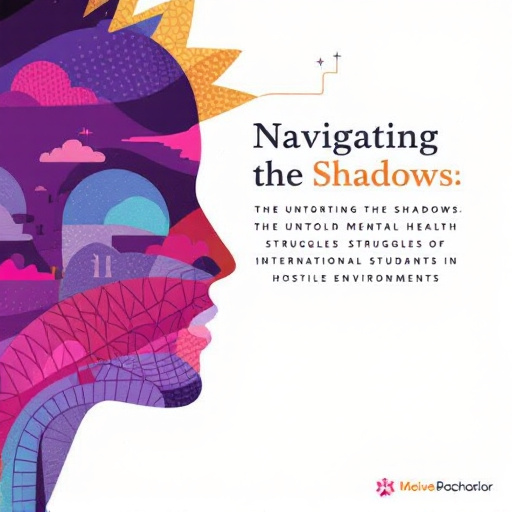Featured Articles
- "Ghosting the Globe: The Rise of International Students' Invisible Struggles in Mental Health Support"
- Navigating Cultural Shock: How International Students Are Redefining Home Away from Home in Unlikely Places
- Navigating Cultural Shock: The Hidden Mental Health Crisis Among International Students in a Post-Pandemic World
- Navigating the Shadows: The Untold Mental Health Struggles of International Students in Hostile Environments
- Navigating the Unknown: How International Students Are Shaping Local Cultures and Communities in Unexpected Ways
"Ghosting the Globe: The Rise of International Students' Invisible Struggles in Mental Health Support"
"Ghosting the Globe: The Rise of International Students' Invisible Struggles in Mental Health Support"
The invisible struggles of international students in navigating mental health support often go unnoticed, leaving many to grapple with loneliness and anxiety. As globalization makes education more accessible worldwide, the urgent need for effective mental health resources tailored to this unique demographic becomes increasingly evident.
The Untold Stories of International Students
Imagine a vibrant university campus: students from various countries engaging in spirited discussions, laughter echoing through the halls, and cultural diversity thriving in every corner. Yet beneath this colorful surface lies a community grappling with unseen mental health challenges. A study by the American College Health Association in 2021 found that 61.5% of international students reported feeling overwhelming anxiety at some point during their academic journey (ACHA, 2021). These are not mere statistics; they represent real individuals navigating the complex web of education in a foreign land.
Culture Shock: The Silent Epidemic
A 2020 report published by the Institute of International Education revealed that over 1 million international students study in the United States alone (IIE, 2020). However, many encounter culture shock, which can manifest as homesickness, confusion, and severe anxiety. Picture Ravi, an enthusiastic engineering student from India, who arrives in the U.S. full of hopes and dreams. A month into the semester, he's buried under assignments and struggles with language barriers—what he calls “the silent epidemic.” Ravi's decline in self-esteem speaks volumes; without proper support, many like him fall into isolation.
A Global Perspective on Mental Health
The narratives of mental health challenges are not confined to the West. For example, in Australia, 25% of international students reported experiencing psychological distress, with limited access to culturally appropriate services (Student Wellbeing Survey, 2021). The unspoken rule seems to be: “You’re here to study, not to complain.” This notion pressures students to suppress their feelings instead of seeking help. The stigma surrounding mental health can often feel like an insurmountable wall, especially for those who come from cultures where discussing emotional difficulties is frowned upon.
The Language Barrier
It’s a typical day at the university counseling center. Sarah, a 20-year-old from Korea, sits in the waiting room, nervously glancing around. While she understands English academically, expressing her inner turmoil proves more challenging than mastering calculus. The counselor, not trained in sensitive communication strategies for international students, inadvertently makes Sarah feel even more isolated. Language should connect us, but for many students, it becomes yet another obstacle in their mental health journey.
Connecting the Dots: The Need for Culturally Competent Services
So, what can be done to bridge this gap? Institutions must prioritize culturally competent mental health resources. This includes providing training for counselors on the unique challenges faced by international students. A collaborative effort between educational institutions and mental health organizations can lead to the development of resources that resonate with cultural nuances, thereby fostering a more inclusive environment.
Leveraging Technology for Support
The digital age offers promising solutions. Mental health apps like “Headspace” and “Calm” have gained popularity among university students, transcending geographical barriers. By integrating multilingual resources and culturally relevant modules, these platforms have the potential to reach international learners who may feel hesitant to seek traditional therapy. Imagine a scenario where Ravi can log into an app during his most overwhelming moments, experiencing a sense of relief through mindfulness practices geared toward his cultural background. The potential impact is profound.
Anecdotal Evidence: Real Voices, Real Change
Let’s take a moment to hear from Melissa, a 22-year-old graduate student from Brazil. She shares, “I remember the first time I reached out to the counseling center. I was terrified, feeling like a burden for wanting to talk about my anxiety. But once I opened up, it felt as if a weight had been lifted. They didn’t just listen—they understood.” Her story highlights the transformative power of effective mental health support tailored to the student experience.
The Role of Peers in Mental Health Support
Peer support is a vital component often overlooked in discussions about mental health. Peer-led initiatives have emerged across campuses to provide a more relatable support system for international students. For example, a buddy system where local and international students are paired can foster mutual understanding and compassion. Engaging in shared cultural experiences can bridge gaps and facilitate open conversations about mental health, thereby creating a community of support.
The Power of Community Engagement
Additionally, extracurricular activities focused on cultural exchange can serve as therapeutic outlets for many. Programs that celebrate diversity not only empower international students but also educate the local student population about mental health issues. As participants bond over shared experiences, they help dismantle the stigma surrounding mental health struggles, creating a safe space where everyone feels heard.
Busting Myths: Mental Health is for Everyone
It’s time to bust the myth that mental health conversations are only necessary when things reach a crisis point. Educational institutions need to disseminate information that underscores mental wellness as a fundamental aspect of overall health. Campaigns that normalize seeking help—and advocate for preventive strategies at all stages—can lead to meaningful changes. As the old saying goes, “An ounce of prevention is worth a pound of cure.” This adage rings particularly true in the contexts of mental health.
Policy Implications and Institutional Responsibilities
Institutions must take a proactive stance on mental health issues by adopting policies that cater specifically to international students. This includes mandatory mental health training for faculty and staff, offering additional counseling hours during peak periods like exam season, and ensuring access to services regardless of a student’s ability to pay. The combination of comprehensive policy frameworks and accessible resources can significantly enhance the mental well-being of this vulnerable demographic.
The Call for Global Collaboration
It’s essential to recognize that tackling these issues requires a global perspective. International collaboration between institutions can lead to shared best practices and resource pooling. Initiatives such as academic exchanges and joint mental health workshops can foster a more cohesive approach to mental health support for international students around the world.
The Future is Bright—If We Act Now
While the struggles of international students are complex and varied, the pathways to addressing these challenges are also multifaceted. Universities, governments, and community organizations hold the key to ensuring that mental health support is not just available, but also effective. By opening our hearts—and our policies—we can build a future where every student, regardless of nationality, feels safe, understood, and empowered to prioritize their mental health.
In the wise words of Maya Angelou, “It’s time to deracialize, demythologize, and destigmatize.” Only through collective efforts can we break the silence that so many feel; we need to hear the voices of international students loud and clear. Academic success should not come at the expense of mental wellness, and it's high time we bring these issues out of the shadows—because no student should feel invisible.
In conclusion, the rise of international students has brought to light an urgent need for tailored mental health support. As we continue to usher in the global education era, let’s commit to not just acknowledging these invisible struggles but actively working to illuminate pathways toward resilience and healing.




